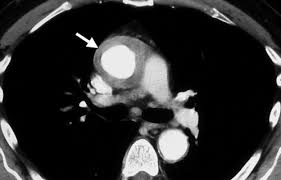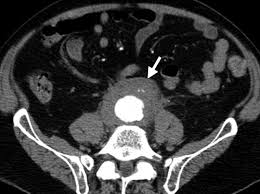
 Aortitis is the inflammation of the aortic wall.
Aortitis is the inflammation of the aortic wall.
It is a rare, but potentially life-threatening disorder.
There are only 1–3 new cases of aortitis per year per million people in the United States and Europe.
Aortitis is most common in people 10 to 40 years of age.
Causes include: trauma, viral or bacterial infections (notably, syphilis), and certain immune disorders and connective tissue diseases.
Aortitis is most commonly seen in patients with syphilis, autoimmune vasculitis (giant cell arteritis, Takayasu’s arteritis), polymyalgia rheumatica, rheumatoid arthritis, and IgG4-related disease.
There is a wide range of symptoms related to the location of the aortic inflammation: fever, chills, muscle pains, and malaise, and hypertension.
Hypertension occurs when the renal artery narrows and elasticity of the aorta and branches decrease.
Aortitis can also be caused by Salmonella infection.
Diagnosis
Physical examination and patient’s medical history, Imaging tests such as magnetic resonance angiography, doppler ultrasonography, and positron emission tomography(PET) can be used to evaluate blood vessels and blood flow, and highlight areas of inflammation.
Treatment:
Dependent on the underlying cause.
The initial treatment of suspected infectious aortitis is intravenous antibiotics with broad antimicrobial coverage.
Immunosuppressive therapy is the primary treatment of non-infectious aortitis due to large-vessel vasculitis.
With GCA or Takayasu arteritis oral glucocorticoid therapy should be initiated.
Adjunctive immunosuppressants, including methotrexate and azathioprine, are added steroids to treat refractory disease or to minimize steroid-induced adverse effects.
If untreated, aortitis has three distinct phases.
A prepulseless inflammatory stage with nonspecific symptoms such as fatigue, arthralgias, and low-grade fevers.
Phase two includes vascular inflammation with pain secondary to the condition, along with tenderness to palpation over the site.
The last phase includes symptoms of ischemia and pain associated with the use of limbs.
